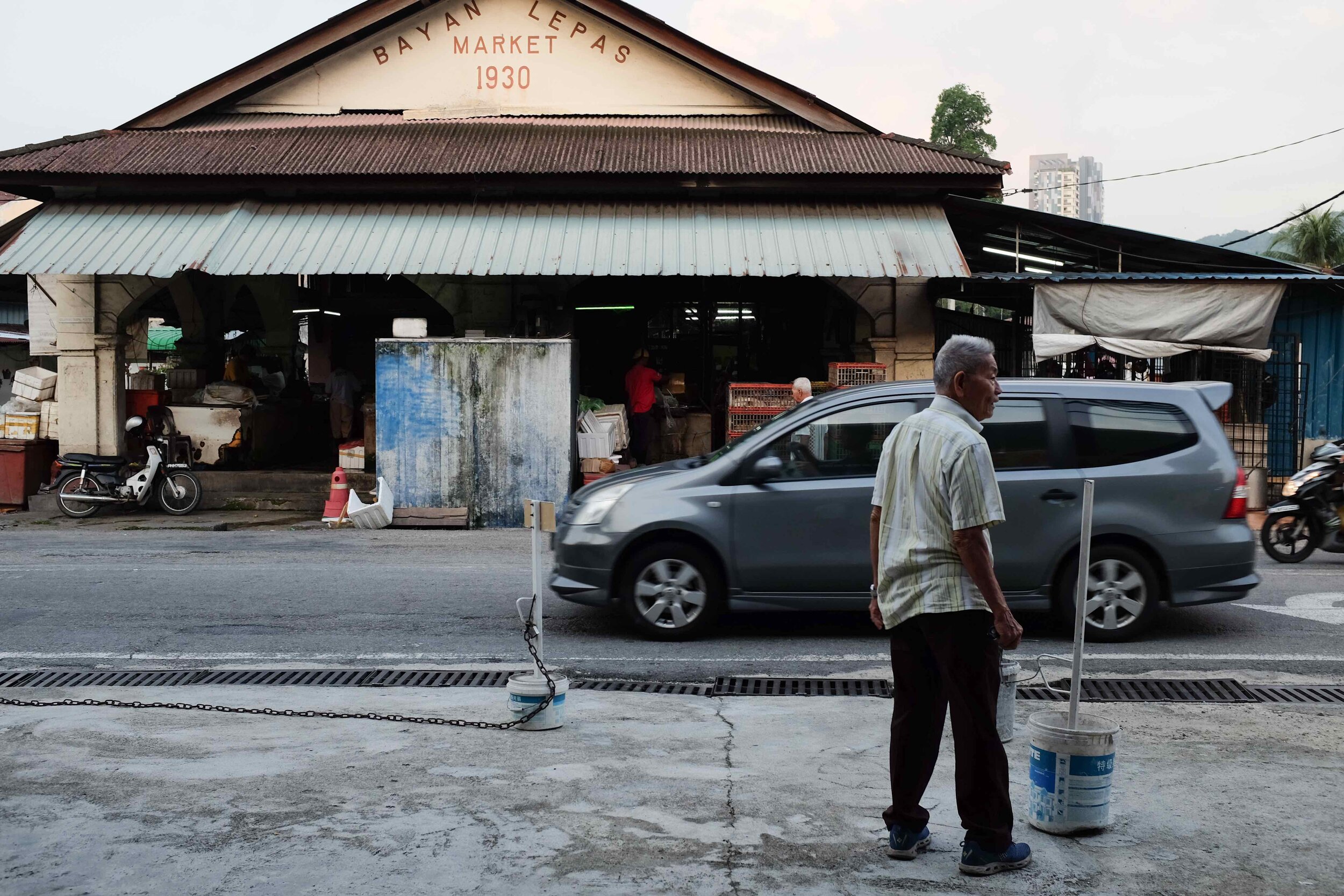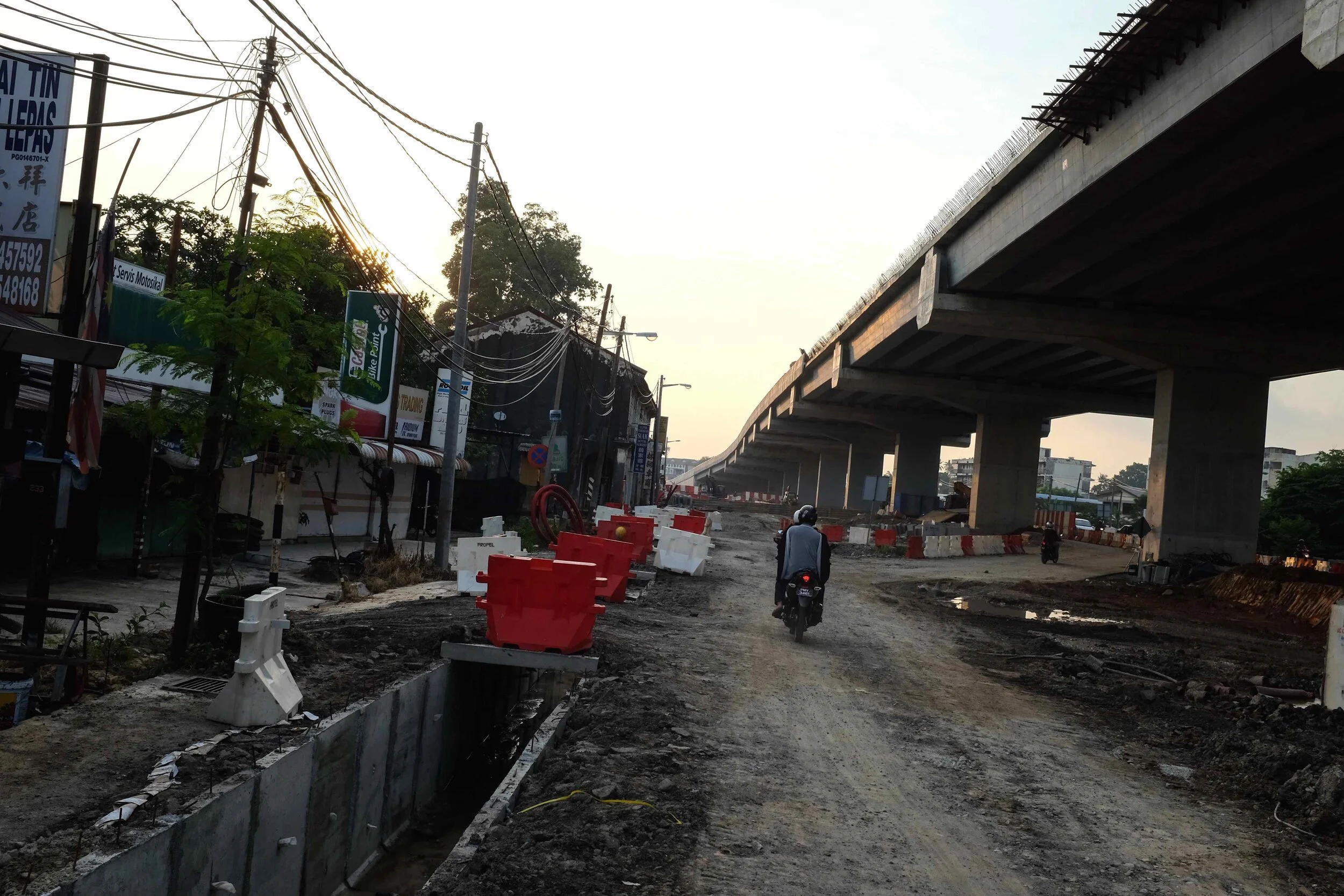A Portrait of Change
Once known as the rice bowl of Penang, not many could have envisioned
Bayan Lepas as the vibrant urbanscape that it is today.
Sweeping paddy fields, dotted by buffaloes and bunkers from days of warfare, used to line the town’s main road. The irrigation network’s countless canals offered fun for the young, when fish fighting and frog catching were common pastimes. It was often referred to as “the other side of the island”, rural and remote.
The 1970s marked its turn towards being a high-tech industrial hub. It eventually blossomed into the “Silicon Valley of the East” and continues to thrive in this dizzying era of big data analytics, e-commerce, cloud computing and the Internet of Things.
This visual account of everyday life in and around Bayan Lepas at present is as much a dip into the past as it is a glimpse of the future.
Turning of a chapter: The proposed Penang South Reclamation (PSR) scheme will see the creation of three new islands off the southern coast, with the intention of funding the Penang Transport Master Plan - an emphatic attempt by the state government to invigorate economic growth by providing sufficient housing and attracting foreign direct investment with an eye towards a smart city ecosystem. Commencement of the project presently hinges on the approval of an environmental impact assessment report and public feedback. Pictured - a fisherman’s wharf at dawn, by the Penang Bridge’s Bayan Lepas exit into Lebuhraya Tun Dr. Lim Chong Eu.
Further down the coastal highway, a cyclist takes a break from the bike route along Persiaran Bayan Indah (a stone’s throw away from the Pulau Jerejak Jetty) - basking in the warm glow of a brand new day.
Standing quietly in the midst of heightened urbanisation is the Bayan Lepas market. It was built in 1930, about five years before the opening of the Penang International Airport. A time when the island was still part of the British crown colony. Given the nature of its location, access to the market in the past year has been adversely affected by a traffic reroute accommodating the construction of a major flyover along the busy Jalan Bayan Lepas.
Hamizan has been selling fish at the market for a decade. While he admits business has taken a hit from current developments - he bears an optimistic outlook, hoping that both his and the community’s fortunes will turn once the projects are completed.
A charming row of pre-war shoplots and a police station once stood where this flyover now stands. They were also built in the 1930s . Notable businesses that remain along this preserved stretch on the left are Siak’s Dental Clinic and Cargas Café – well known among the locals for its nasi campur. Go for the fried chicken and stingray curry, they say.
A rejuvenating retreat: The Bukit Jambul hiking trail is easily accessible, well-paved, and offers a brilliant panorama of the island’s southeastern front and the mainland across the horizon. A hike to the top takes between 10 to 40 minutes, depending on fitness level. The atmosphere at the top used to be more communal with the presence of a free-for-all gym and a tea kiosk ran by a like-minded group of hikers. While that has changed, the hill remains a favourite for many.
Given the rate of surrounding urban development, the significance of Bukit Jambul and its neighbouring hills as an avenue of recreation and natural habitat for diverse flora and fauna cannot be overstated. Here, two friends catch a breather with a bird’s-eye view of the expansive Second Penang Bridge and the Bayan Lepas Free Industrial Zone (FIZ). Established in the early 70s, the Bayan Lepas Free Trade Zone (FTZ) as it was known then is the brainchild of the late Tun Dr Lim Chong Eu - the second Chief Minister of Penang. A man fondly remembered for his vision and passion in transforming a slumberous tourist destination into a global manufacturing powerhouse.
On lower ground, an already-thriving community steps up a gear. Reclamation works for the Queens Waterfront project by local developer Ideal Property Group is in full throttle. Located in front of Queensbay Mall, more than half of this freehold development will sit on reclaimed land, featuring residences, a waterfront promenade, a public sports centre and an international school. Some residents have raised their concerns about ecological implications.
A story of firsts. “Back then, almost the entire town was made up of paddy fields and coconut plantations. It was swampy. Imagine, we had snakes and pests constantly entering the buildings.” The arrival of Intel in Penang marked the semiconductor manufacturer’s very first offshore assembly operation. It was 1972, a time when the concept of using a computer was still virtually unknown. Hired to kickstart on-ground operations, Mr. Gordon Tan was Intel Penang’s very first employee. His storied journey with the now-global company, one that wildly ranges from turning a canteen into a makeshift manufacturing plant following a fire to being trained by the FBI in Arizona - spans almost four decades. Today, seemingly sharp as ever, he oversees security for the Gurney Paragon mall.
Jalan Tokong Ular: Bayan Lepas’ very own street of harmony. Sitting side-by-side along this 400-metre stretch is the Snake Temple (or Tokong Ular), a Sivan temple, the Charismatic Church of Penang, the Gurdwara Sahib Bayan Baru and the Than Hsiang Temple. This road runs perpendicular to Sungai Kluang, a river that snakes through the industrial zone and into the Straits of Malacca.
A contemplative, cloudy morning at the Sri Vishwanather Visalatchi Alayam as a devotee holds special prayers. Consecrated in February 2009, it is also known as the Bayan Baru Sivan Temple.
The 167-year-old Snake Temple was built in honour of Chor Soo Kong, a Chan Buddhist monk who lived in the Hokkien Province during the Sung Dynasty. It sits on an elevated plot of land, donated by a European devotee said to have been healed by the monk. Snakes, specifically pit vipers, began slithering in not long after it was built. They made it their home and eventually grew into a showpiece for the temple. Here, a family revels in the opportunity of an exotic portrait – a small viper was placed on the older aunty’s head shortly after this photograph was taken, to which she remained smiling and unmoved.
When he was elected into parliament in 2013, YB Sim Tze Tzin’s mission was to develop the liveability of Bayan Lepas and its surrounding townships into an ecosystem where families and individuals alike can balance living, work and play. Encouraged by the introduction of affordable housing projects, more municipal parks and a Class 1 (dedicated and physically protected path) cycling route that stretches along the coast of Bayan Lepas into George Town, the Bayan Baru MP is currently focused on alleviating traffic congestion and stimulating more job opportunities especially in the tech and manufacturing sectors. Pictured here is YB Sim with his team in the midst of handing out aprons to food vendors during a Ramadan bazaar visit.
Mr. Albert Lee, a resident of Bayan Baru since 1980, believes that if you hope for positive changes in your own community, you need to participate. Be the change you want to see. Today, he represents a senior figure in the Resident’s Association and is a member of the neighbourhood safety committee (JKKK) set up by the state government. Having worked in the service industry, meeting people and making friends have always come naturally but he adds, “I do this because I’ve been blessed. With a family, a household, a career. This is an opportunity for me to share and give back.” Standing behind him is his youngest son Edric, who is home for a visit before heading off to Holland for his 2017 SEA Games preparations. Edric represents Malaysia in equestrian.
It’s 10AM on a Saturday morning. The Bayan Baru Market Complex is full of life. Residents both young and old navigate crowded aisles in search and purchase of weekly provisions. One fishmonger in particular belts out Chinese classics while scaling fish – he does this on a daily basis. The adjoining food court is just as alive, offering a multitude of reasonably priced and tasty local cuisine. Uncles and aunties are seen regaling each other with stories over breakfast and coffee. For a landscape that constantly redefines itself to meet the ever-changing demands of technology and industry – its townships, communities, and mornings such as these remain both constant and meaningful.













